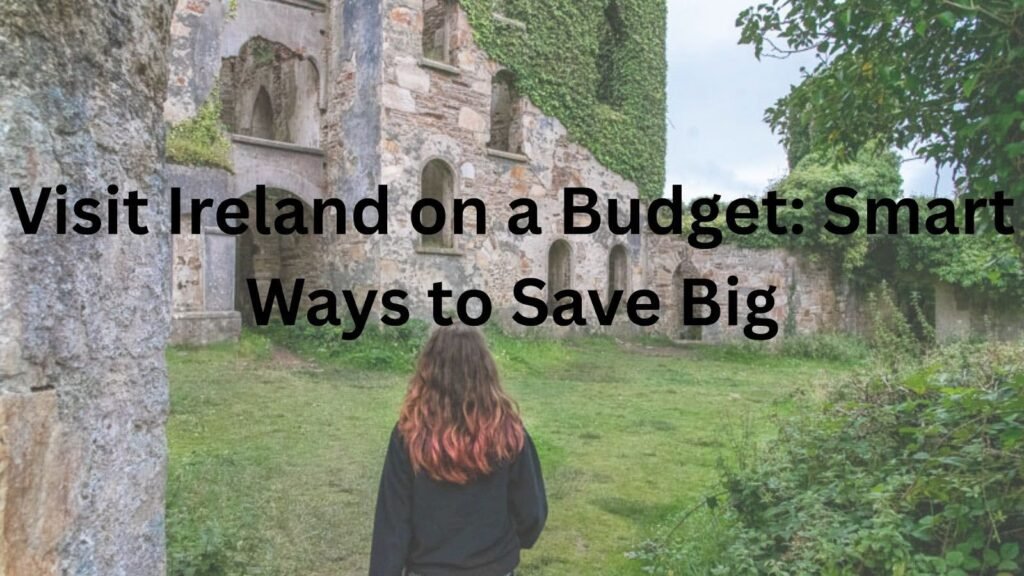Many people think Ireland costs too much to visit. The truth? You can see this beautiful country without spending a fortune. Ireland offers green hills, old castles, friendly people, and lively cities. Yes, prices can be high, but smart planning makes a big difference.
This guide shows you exactly how to visit Ireland on a budget. You’ll learn where to save money on hotels, food, and activities. We’ll cover the best travel times, cheap ways to get around, and free things to do. With the right approach, you can experience Ireland’s magic without emptying your wallet.
Let’s look at practical ways to make your Irish trip affordable and memorable.
Essential Budget Planning for Your Irish Trip

Planning is the key to keeping costs down. When you know what things cost and when to go, you can visit Ireland on a budget much more easily.
Setting a Realistic Daily Budget
Your daily costs in Ireland depend on your travel style. A backpacker staying in hostels and cooking meals might spend €40-60 per day. Someone choosing mid-range hotels and eating out occasionally needs about €80-120 daily. Comfortable travelers picking nice hotels and restaurants should plan for €150-200 per day.
Split your money smartly across different needs. Typically, accommodation takes 40% of your budget, food about 30%, transportation 20%, and activities 10%. Adjust these numbers based on what matters most to you. If you love eating out, spend less on lodging and more on meals.
Best Times to Visit for Lower Costs
Travel dates dramatically affect your spending. November through March offer the lowest prices, except during Christmas and New Year. Hotels cost 30-50% less than summer rates. You’ll find fewer tourists and better deals on activities, too.
Spring months (April and May) and fall months (September and October) give you good weather with lower prices. These shoulder seasons offer mild temperatures and smaller crowds. Accommodation costs less than peak summer, and you’ll still enjoy long daylight hours for sightseeing.
Free and Low-Cost Resources
Ireland provides many free resources for visitors. Tourism offices in every major town offer free maps, guides, and helpful advice. Staff members share insider tips about local attractions and events.
Most big cities run free walking tours where guides work for tips only. These tours teach you about history and culture while showing you around. Ireland also has countless free natural spots, including public parks, beaches, hiking trails, and scenic viewpoints. National parks charge no entrance fees, giving you access to some of the country’s most beautiful landscapes.
Affordable Accommodation Options
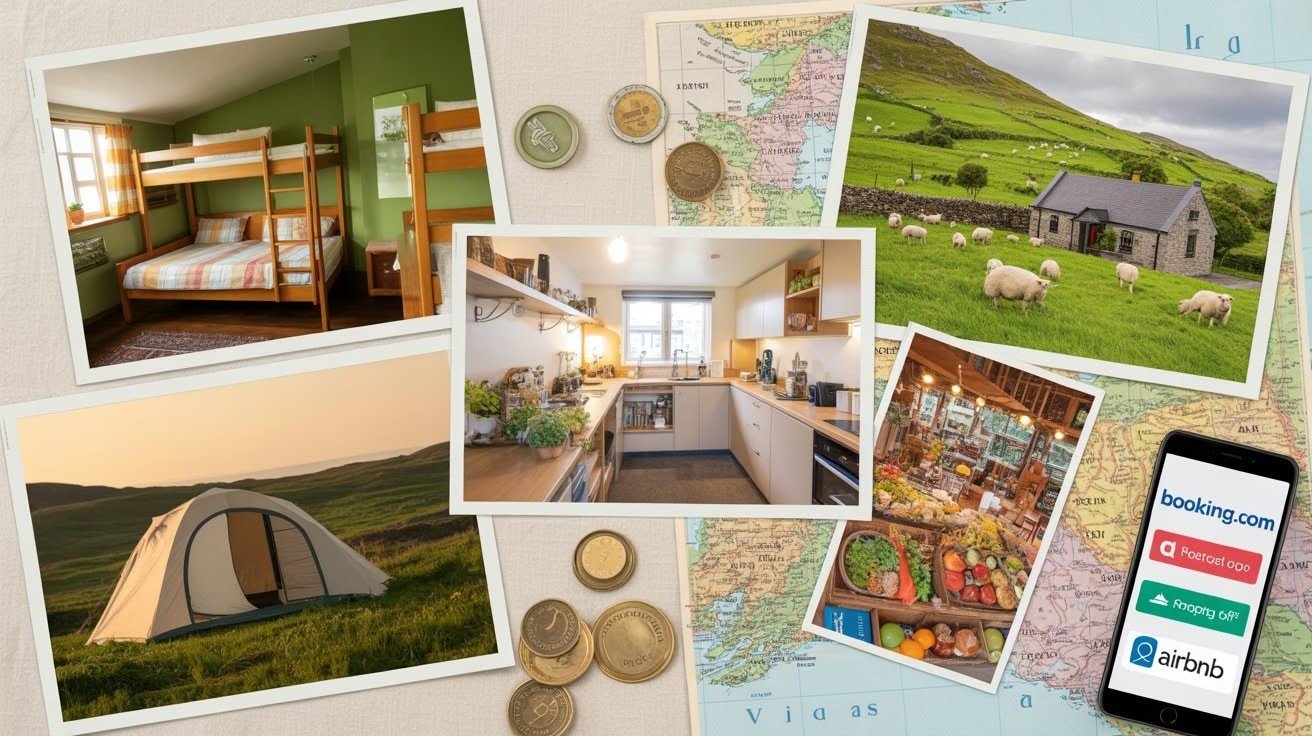
Where you sleep matters for your budget. Ireland has plenty of cheap places to stay if you know where to look.
Hostels and Budget Hotels
Hostels are perfect for budget travelers. Chains like Generator Hostels and independent spots offer clean, safe beds starting at €15-25 per night for dorm rooms. Private rooms in hostels cost €40-60, still cheaper than most hotels.
Check sites like Booking.com, Hostelworld, and Airbnb for deals. Book early for better prices, especially during the summer. Many hostels include free breakfast and have kitchens where you can cook, saving even more money.
Self-Catering Stays
Renting an apartment with a kitchen cuts food costs significantly. You’ll pay €60-100 per night for a basic apartment, but cooking your own meals saves €20-40 daily compared to eating out.
Irish supermarkets sell fresh ingredients at reasonable prices. Shop at local markets on weekends for fresh produce, cheese, and bread. Cooking just breakfast and a few dinners during your trip adds up to big savings.
Alternative Lodging
Rural B&Bs and farm stays offer authentic experiences at good prices. These family-run places charge €35-50 per person with breakfast included. You’ll meet locals and get travel advice too.
Consider house swapping websites if you own a home. Some travelers also choose camping, with sites costing €10-20 per night. Glamping sites offer more comfort at €40-80 per night, still less than hotels in popular areas.
Getting Around Ireland Without Breaking the Bank
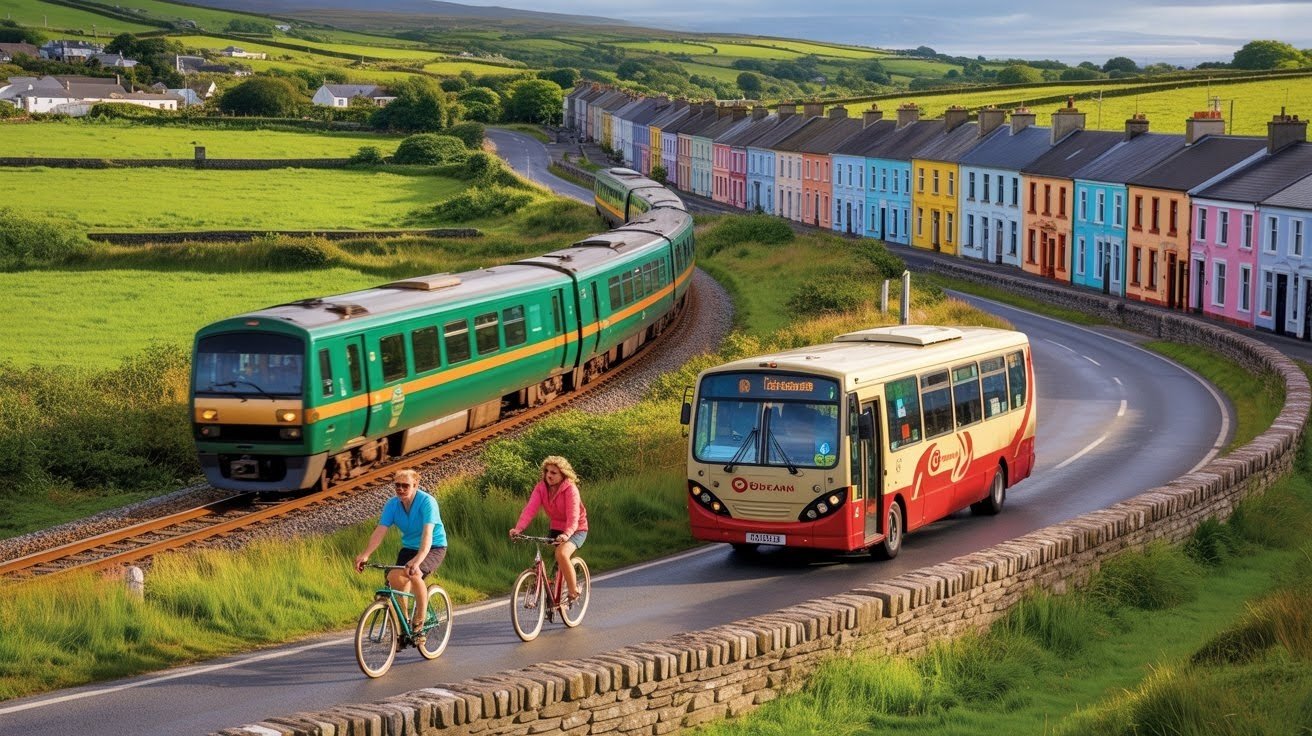
Transportation can eat your budget quickly, but Ireland has affordable options.
Bus Eireann runs regular services throughout the country at reasonable rates. City buses in Dublin, Cork, and Galway cost €2-3 per ride. Irish Rail connects major cities, with tickets starting at €10-15 when booked early.
- Book trains and buses online weeks ahead for cheaper fares
- Buy multi-day passes if you’re taking several trips
- Get a Leap Card in Dublin for discounted bus and train rides
- Ask about student, senior, or family discounts
- Consider tourist cards that bundle transportation with attractions
- Walk around city centers instead of taking taxis
- Rent a bike for €10-15 per day to cover more ground
Planning your route carefully helps too. Group nearby attractions together to reduce travel between cities. Sometimes a slightly longer bus route costs much less than the express option.
Eating Well on a Budget

Food in Ireland doesn’t have to drain your funds. Smart choices keep you fed without overspending.
Supermarket Shopping Strategy
Discount chains Lidl and Aldi offer the best grocery prices. You’ll find quality food at 30-40% less than other stores. Tesco and Dunnes Stores run regular sales worth checking too.
Plan simple meals using local ingredients. Irish butter, cheese, bread, and vegetables taste great and cost less than processed foods. Buy seasonal produce at outdoor markets for the freshest options at lower prices.
Dining Out Smartly
Pubs serve hearty lunch specials for €10-15, much cheaper than dinner prices. Many restaurants offer early bird menus between 5-7 PM with three courses for €20-25. Regular dinner mains cost €15-25 at sit-down restaurants.
Cafes provide better value than fancy restaurants. You’ll get sandwiches, soups, and pastries for €5-10. Takeaway fish and chips cost around €8-10. Food markets in cities like Dublin and Cork sell fresh, affordable meals from various vendors.
Free and Affordable Attractions
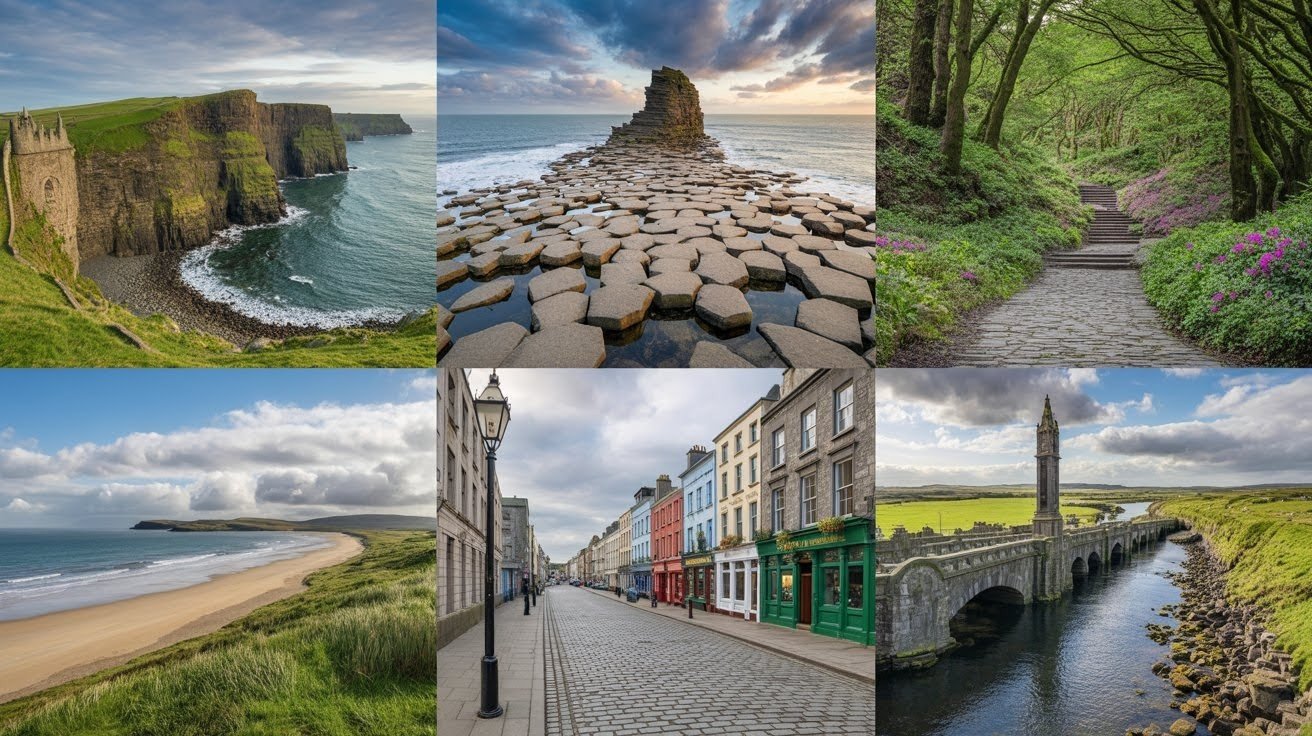
You can visit Ireland on a budget while still seeing amazing sights. The country offers incredible free experiences.
Ireland’s natural beauty costs nothing to enjoy. The Wild Atlantic Way stretches 2,500 kilometers along the coast with free access. Walk the Cliffs of Moher coastal path (different from the paid viewing platform) or visit any of the country’s stunning beaches.
- Hiking in Killarney National Park or the Wicklow Mountains
- Walking along beaches in County Kerry or County Donegal
- Viewing the Giant’s Causeway in Northern Ireland
- Visiting free museums in Dublin, like the National Museum and the National Gallery
- Attending traditional music sessions at pubs (just buy a drink)
- Touring historic neighborhoods in Cork, Galway, and Limerick
- Exploring Trinity College grounds in Dublin
- Watching street performers on Grafton Street
Many historic sites charge only €3-5 entrance fees. Check for free entry days at major attractions. Download free walking tour apps that guide you through cities at your own pace.
Save the expensive attractions for things you really want to see. Choose one or two paid highlights like the Guinness Storehouse or Book of Kells, then fill your itinerary with free activities.
Money-Saving Tips for Activities and Entertainment
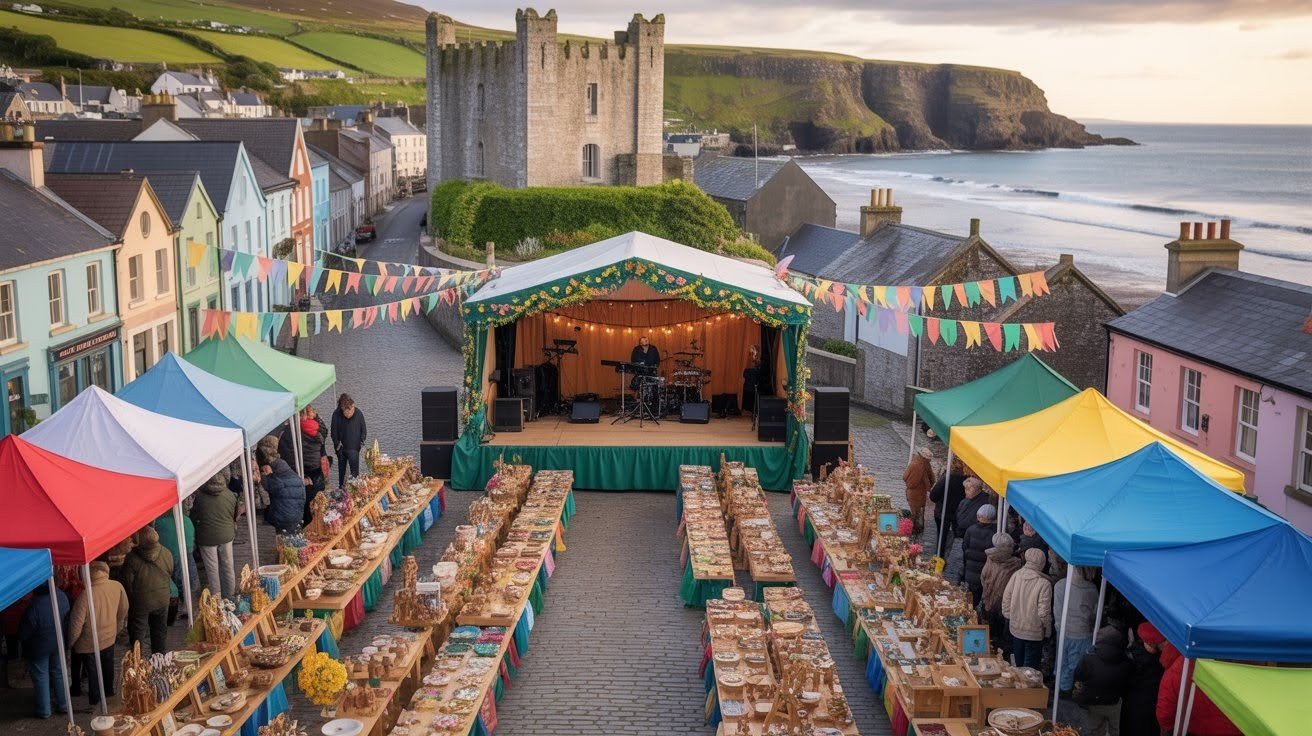
Activities add up quickly, but discounts help stretch your budget. Buy a Heritage Card for €40 if you plan to visit several historical sites managed by the Office of Public Works. The card pays for itself after four visits and covers over 40 locations. Look for combination tickets that bundle multiple attractions at reduced prices.
- Check for family packages that cost less than individual tickets
- Book tickets online in advance for 10-20% discounts
- Attend free festivals happening throughout the year
- Ask about student or senior rates with a valid ID
- Visit attractions on free entry days (usually one day per month)
- Join group tours that split costs among participants
Local tourism websites list community events, concerts, and festivals. Many towns host free traditional music nights, markets, and cultural celebrations. These authentic experiences cost nothing and connect you with Irish culture.
Time your visit around special events when possible. Food festivals, music weekends, and cultural celebrations often include free activities alongside paid ones.
Conclusion
Ireland welcomes all types of travelers, including those watching their spending carefully. With smart planning, you absolutely can visit Ireland on a budget and have an amazing time.
Focus on what matters most to you. Love history? Spend on castle tours but save by cooking meals. Prefer nature? Stay in hostels and spend your days hiking free trails. The key is making intentional choices about where your money goes.
Start planning now with your budget in mind. Research accommodation options, compare transportation costs, and list free activities in areas you’ll visit. Small savings in each category add up to significant amounts.
Remember that great trips come from experiences, not expensive purchases. Ireland’s friendly people, beautiful landscapes, and rich culture create memories regardless of how much you spend. Your Irish trip can be both affordable and unforgettable.
Frequently Asked Questions
How Much Money Do I Need Per Day in Ireland?
Budget travelers need €40-60 daily for hostels and self-catered meals. Mid-range visitors should plan €80-120 for modest hotels and occasional dining out. Luxury travelers spending on nice hotels and restaurants need €150-200 per day or more.
Is It Cheaper to Visit Dublin or Rural Ireland?
Rural Ireland costs significantly less than Dublin. Accommodation, food, and activities in countryside areas run 30-50% cheaper than in the capital. Small towns and villages offer the best value for budget-conscious travelers seeking authentic experiences.
Can I Use Credit Cards Everywhere in Ireland?
Most hotels, restaurants, and shops accept credit cards throughout Ireland. However, small rural pubs, markets, and some B&Bs prefer cash. Carry €50-100 in cash for emergencies. ATM fees typically cost €3-5 per withdrawal, so withdraw larger amounts less frequently.
What Are the Hidden Costs When Traveling in Ireland?
Watch for service charges (10-15%) added to restaurant bills. Tipping isn’t required, but €1-2 for good service is common. Tourist attractions may charge extra for parking (€5-10). Bus and train tickets cost more when bought on board versus online.
Are There Any Discount Cards Worth Buying for Tourists?
The Heritage Card (€40) saves money if visiting multiple historic sites. Dublin’s Leap Card offers discounted public transportation. The Dublin Pass bundles attractions, but calculate if you’ll actually visit enough places to justify the cost before purchasing.

